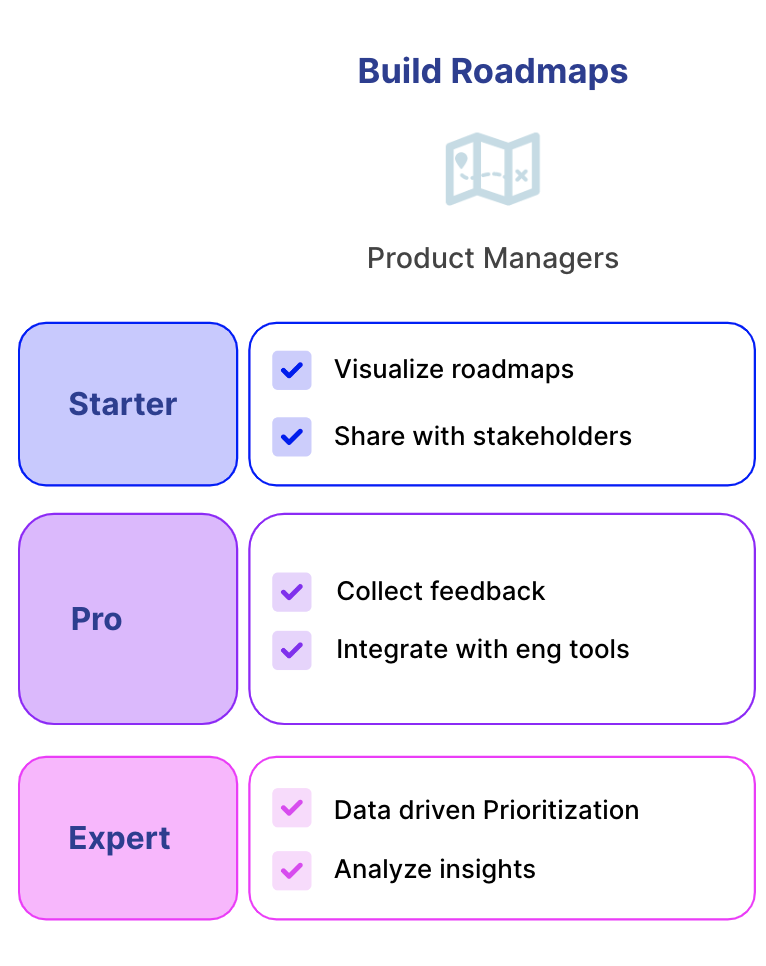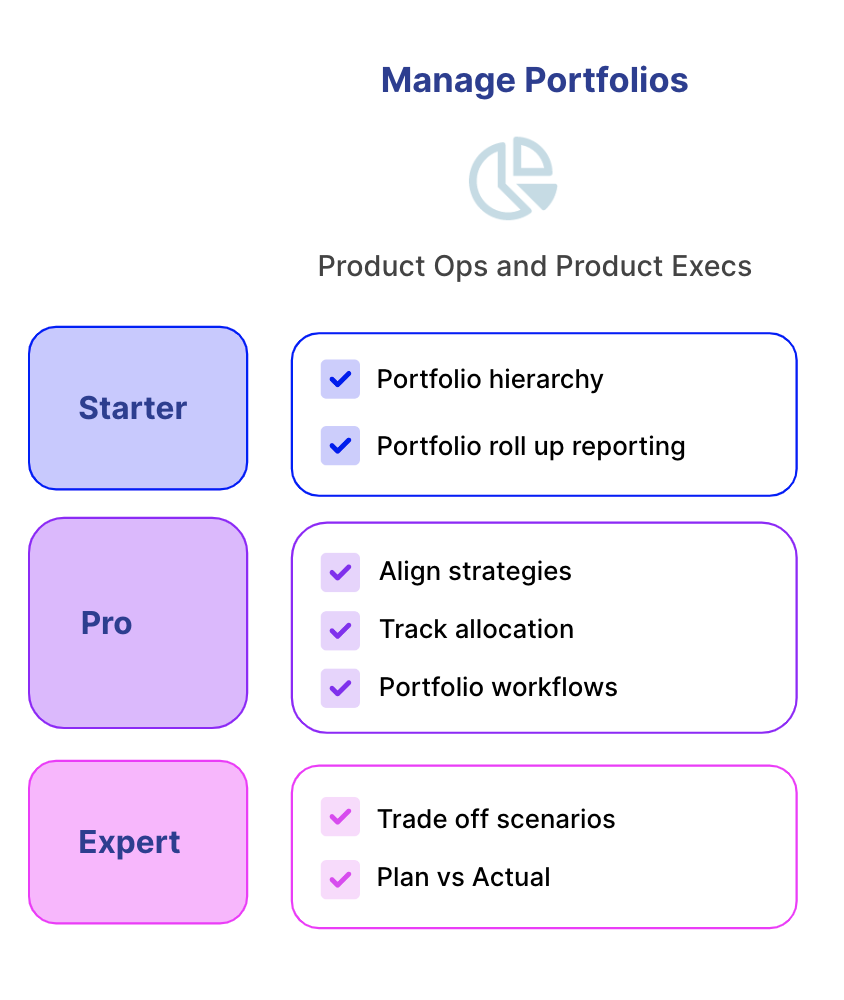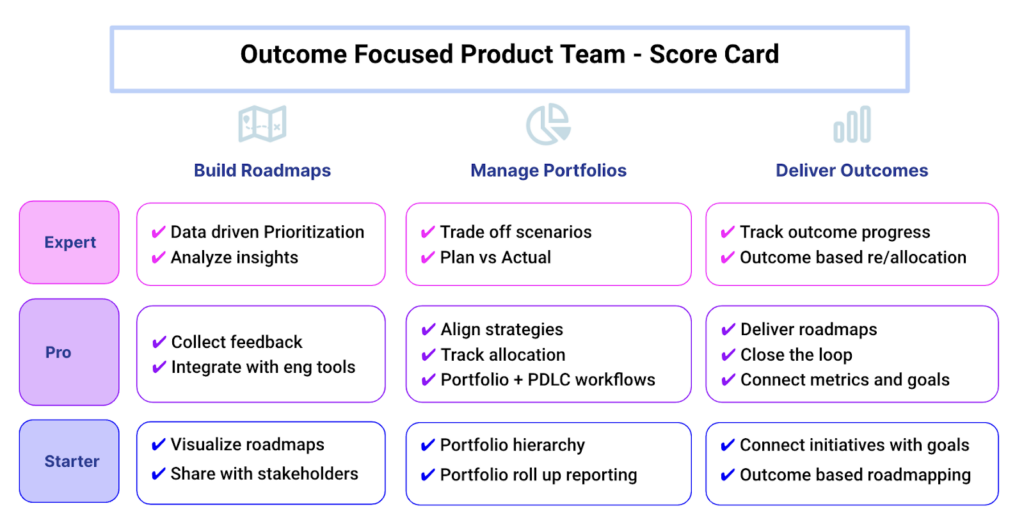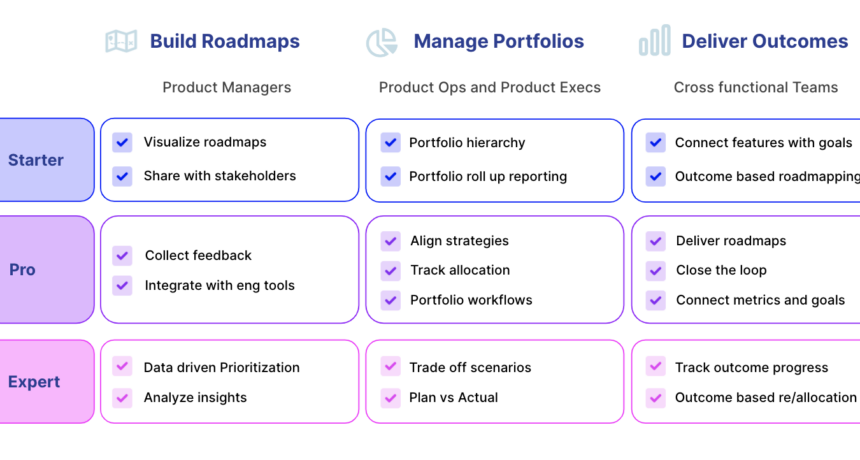To deliver the outcomes expected by customers and business, every product organization has to be able to
- Build roadmaps
- Manage portfolios
- Deliver outcomes
While every product team fulfills these 3 needs to varying degrees, mastering all of 3 is essential to become fully outcome-focused. It takes a journey, like Maslow’s hierarchy of needs pyramid, each step of the way relies on having some the one before it in place.
Under the leadership of Chief Product Officer (CPO), who champions a portfolio management approach, product teams can elevate their skill levels across all these needs and accelerate the overall portfolio outcomes.
In this post, we’ll break down the pyramid and outline how teams progress in each of these 3 needs and become an expert in delivering outcomes. Let’s get started.
Need #1 – Building Roadmaps
Roadmap is a way to communicate product plans and the reasons behind them. Every product team, every product manager, or in fact, every person, may have one or multiple flavors of roadmaps. (Check out the 10 most popular roadmap templates for every Product Manager)
What does it take to build an effective roadmap? Here are the key elements for 3 levels of expertises.

As you may see above, there are more to building an effective roadmap than just some pretty visualizations. Here is a summary of 3 levels of maturity on building roadmaps.
- The starter roadmap building includes visualize roadmaps and share with stakeholders.
- More advanced roadmapping involves collecting customer and market feedback or insights, and Integrating roadmap data with engineering tools such as Jira, Azure Dev Ops (ADO), Shortcut, Github issues, etc. to connect strategies with delivery.
- The expert roadmap builders incorporate a data driven approach to prioritize features and ideas, and analyze insights gleaned from customer and market feedback to form and adjust product strategies that inform the roadmap.
If your teams are stuck using spreadsheets or PPT slides, they can quickly become outdated the minute they’re created. A tool like Dragonboat helps thousands of teams build product roadmaps. Dragonboat helps you to create various formats of roadmaps that communicate to various stakeholders with a tailored story.
Everything listed here stems from a foundation of product portfolio management (PPM). Learning about and taking a mindset of PPM (as opposed to traditional product management) will lay the foundation you need to progress to the next level.
Need #2 – Managing Portfolios

You may think only very large companies with multiple products require portfolio management, you’d be surprised.
Even small product teams need to adopt a portfolio mindset and apply allocation and trade off in product decisions.
Wyatt Jekins, SVP of Product, Procore
Similar to the 1st need (building roadmaps), the 2nd need – managing portfolios, may also be practiced at 3 levels.
- For starters, portfolio management involves having various levels of portfolio items, such as initiatives and features, or having multiple teams or even portfolio of goals (aka multi-dimensional portfolio, a concept of Responsive Product Portfolio Management)
- More advanced portfolio management involves aligning strategies and product/ resource allocation so that strategies are effectively supported. Another key element of effective portfolio management is to create and operate an effective portfolio workflow and cadences (aka portfolio rhythms) which ties longer term goals and near term execution together.
- The expert portfolio managers practice effective scenario analysis on various roadmap and product allocation and timing may affect the outcome of their product organization. And they also play close attention on plan vs target both in terms of roadmap progress, and investment spent.
As you can see managing a portfolio requires much more data points, with broader scope, and more complex and frequent analysis..Most companies rely on a spreadsheet guru to run it, or sadly sometimes they simply don’t do it for lack of the tooling.
In addition to centralizing user feedback and internal requests, product teams taking a portfolio approach start to do the following during the pro phase of their maturity:
- Integrate roadmap data with engineering tools for 2-way dynamic sync with Jira or other dev tools
- Visualize strategies and dependencies
- Automatically connect the dots and track all the moving pieces for real-time portfolio planning and allocation
- Provide estimates and plan across multiple portfolio levels
With the above in place, you are well on your way to:
- Deliver your roadmap commitments
- Close the loop by automating the right updates to the right audience
- Connect metrics and goals, bringing visibility to the entire organization
This is why an effective CPO and effective product organization adopts a portfolio management too like Dragonboat. Understanding the importance of aligning all teams to focus on outcomes and putting that belief into action is the difference between a pro and starter product team.
Need #3 – Deliver Outcomes
Knowingly or not, every product organization needs to deliver outcomes. Feature focused companies leave the responsibility of delivering outcome solely to the executives, which results in either be hit or miss goals, or ad hoc micro management.
Shifting your organization from feature-based roadmapping to outcome-based may take 3 levels of organizational maturity

- At the most basically level, product teams connect features with goals and build outcome based roadmaps (aka goal swim lane)
- As the teams become more versed in outcome focused practice, product teams engage collaboratively with the engineering and other delivery teams to ensure effective planning and ability to deliver roadmap commitments. Delivering commitment is essential not just to check dates, it’s essential because the rest of the company often relies on product delivery to market the right product at the right time, align the timeline and customer promise by sales teams and customer success teams.
- The expert in delivering outcome requires the ability to connect metrics and goals, and responsively adjust product investment allocation and prioritization framework based on changes.
Side bar
Need to normalize the prioritization framework across multiple teams and roadmaps? Check out the MoAR model, which stands for Metrics over Available Resources. This is a unique framework for responsive product portfolio management, and it replaces the traditional ROI model.
MoAR = Benefit towards Goals / Effort
When you prioritize your roadmap with MoAR, you can directly map to company goals and strategies while accounting for urgent resourcing needs.
The MoAR model is one of several built-in frameworks within Dragonboat.
Putting It All Together: Summary
As you can see, every product organization has 3 essential needs – building roadmaps, managing portfolios and delivering outcomes. In each of these needs there is room for improvements from starter to pro to expert.
Where is your product team at in this journey? Take a quick self test here.

Interested to learn how to advance your outcome focused product practice? Hear more from Chief Product Officers of market-leading companies like Shopify, Pendo, and Procore in our CPO Series webinars.



